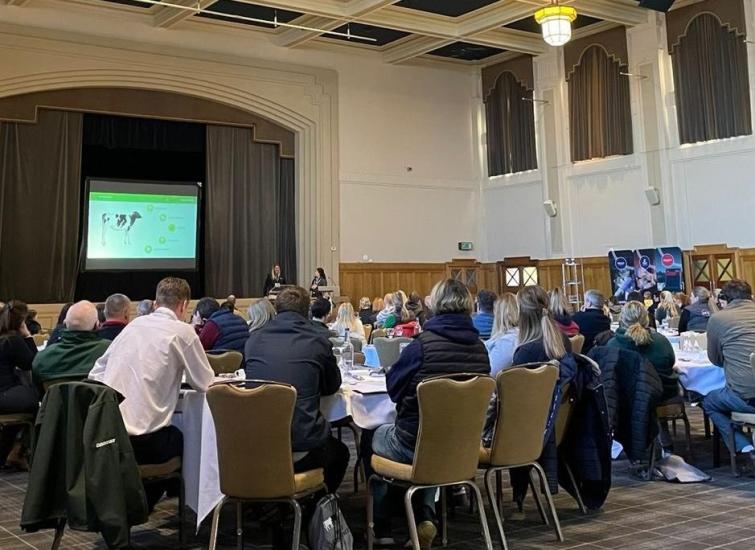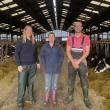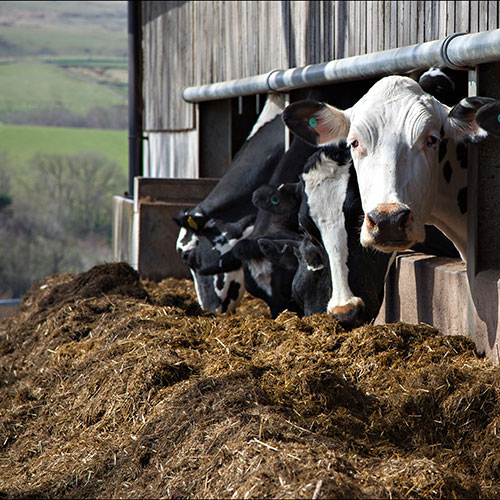Advanced Robot’s experience means they are always challenging me to get the best out of the cows, they maintain the herd’s health status whilst also improving performance.
Enhancing Heifer Rearing Success
Advanced Nutrition’s Heifer Rearing Manager, Liz Newman was among the key speakers, focusing on post-weaning success at the Calf Conference 2025 in Dumfries.

The Calf Conference 2025, held at Easterbrook in Dumfries, brought together industry experts, researchers, and farmers to discuss the latest advancements in calf and heifer rearing. Advanced Nutrition’s Heifer Rearing Manager, Liz Newman was among the key speakers, focusing on post-weaning success and data-driven approaches to optimise heifer development.
The conference presentation started with the calf-rearing phase, highlighting the crucial role of colostrum management. Delegates were introduced to the latest veterinary research on colostrum cleanliness, absorption, and effective measurement techniques. In addition to early nutrition, the discussion also covered housing and environmental factors, providing a comprehensive overview of optimal calf-rearing practices.
Post-Weaning Success
Our heifer rearing manager Liz looked at the post weaning phase.
“The first two years of a heifer’s life are critical, with key performance indicators (KPIs) guiding their growth and development. We expect a lot from our heifers, how we can ensure they can achieve their full potential?” comments Liz.
Growth rates are a major focus in youngstock management, particularly in the early months. If heifers do not achieve sufficient growth during this period, they risk reduced performance when they enter the milking herd. However, growth is only one part of the equation. Facilities, management, nutrition, and overall health play equally vital roles in ensuring smooth herd integration and long-term profitability.
Utilising Data to Drive Decisions
Liz highlighted how data analysis can guide heifer rearing strategies. Advanced Heifer uses a range of metrics, including daily live weight gain (DLWG), veterinary costs, mortality rates, and passive transfer results, to assess and optimise rearing practices.
Current research demonstrates that optimising DLWG at key stages of heifer rearing can significantly enhance first-lactation milk yields. By considering feed efficiency and costs, we can strategically target optimal growth at the right time and at the most effective cost.
Interestingly the 2023 NMR report highlighted key industry benchmarks, showing an average herd size of 178 cows, a 305-day yield of 8,991kg, and a cull rate of 28%. Our data analysis across all farms reveals that, on average, heifers produce 77.4% of an adult cow’s 305-day yield, with the top 10% reaching 80.6%. However, the target range should be 82–85%. This shortfall means that, on average, a heifer produces 413kg less milk in her first lactation. With approximately 50 heifers in lactation per herd, this results in a loss of 20,650kg of milk annually for the average farm.
The team discussed various farm examples, including growth rates and health challenges such as morbidity and mortality. For instance, poor growth rates between three to six months are often linked to the weaning strategy. One example involved foot-trimming records showing corkscrew claws in heifers, which can be traced back to rearing conditions. In those cases, we would examine factors like feed fences, stocking density, and walking surfaces. Additionally, digital dermatitis (DD) often originates in heifers, with infections commonly beginning in sheds where cows are exposed to high ammonia levels.
Another case involved a farm struggling with maiden heifer fertility, despite strong fertility rates in the milking herd. The same AI technicians, heat detection methods, and semen were used, yet conception rates remained low. The issue was ultimately traced to a deficiency in vitamins and minerals, as the heifers were being underfed. After top-dressing their diet with the necessary minerals, conception rates improved significantly from 40% to 60%.
Ensuring Optimal Nutrition Post-Weaning
Another common challenge the team identified is the post-weaning dip, where heifers fail to maintain growth momentum. Industry focus is often on pre-weaned calves, yet post-weaning nutrition remains crucial for continued development. Heifers that do not reach the required body weight and stature before pregnancy cannot make up the deficit later.
Nutritional strategies should prioritise high-quality rearing feeds and balanced diets post-weaning, supporting skeletal growth and reproductive development. By six months, feeding can be adjusted to incorporate more cost-effective options while still maintaining necessary growth rates.
Data-Driven Heifer Rearing
Many farms collect extensive data on pre-weaned calves but fail to track heifer performance post-weaning. We work with our farms to ensure that audits incorporate multiple data points, allowing for targeted recommendations that optimise growth, reduce health issues, and improve overall herd efficiency.
If you’d like further information on calf and heifer rearing, get in touch with our Advanced Heifer Team.
〈 BACK



